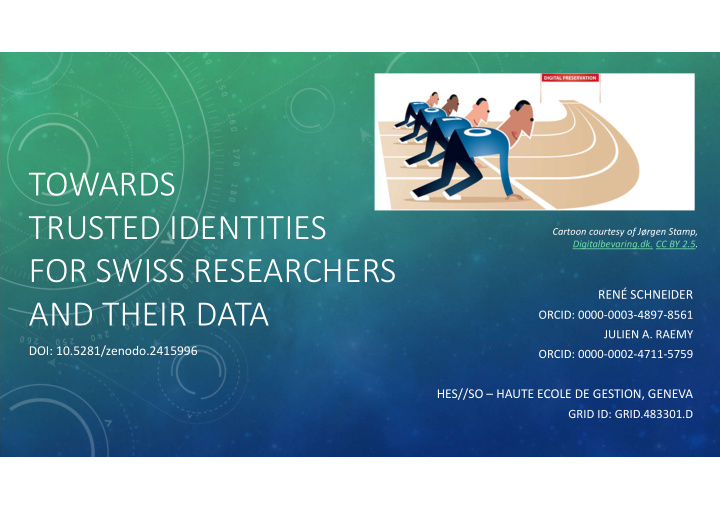



TOWARDS TRUSTED IDENTITIES Cartoon courtesy of Jørgen Stamp, Digitalbevaring.dk. CC BY 2.5. FOR SWISS RESEARCHERS RENÉ SCHNEIDER AND THEIR DATA ORCID: 0000-0003-4897-8561 JULIEN A. RAEMY DOI: 10.5281/zenodo.2415996 ORCID: 0000-0002-4711-5759 HES//SO – HAUTE ECOLE DE GESTION, GENEVA GRID ID: GRID.483301.D
DOI: 10.5281/zenodo.2415996
DOI: 10.5281/zenodo.2415996 Cartoon courtesy of Jørgen Stamp, Digitalbevaring.dk. CC BY 2.5.
DEFINITION PERSISTENT IDENTIFIER A persistent identifier is a long-lasting and biunique* reference to a digital resource. *biunique: unique in both directions (bijective)
DEFINITION II A kind of ISBN for data and more, for everything that can represent a ressource.
COMPOSITION https://www.slideshare.net/AustralianNationalDataService/fsci-persistent-identifiers Usually it has two parts: 1. A unique identifier (ensures the provenance of a digital resource) 2. A Location for the resource over time (ensures that the identifier resolves to the correct location) Eugene Barsky (https://www.slideshare.net/ORCIDSlides/dois-and-other-persistent-identifiers-in-research-data-eugene-barsky)
PID PID • Publications • Data • Persons • Organisations • Citations and more: (antibodies, fictious characters, places, plants, e-books, …)
RISKS PID Crisis: PURL -> long-lasting PIDs need long-lasting institutions! Zombie PIDs -> PIDs need Data Curation!
Cartoon courtesy of Jørgen Stamp, Digitalbevaring.dk. CC BY 2.5.
• Why this project? • Why PIDs? Cartoon courtesy of Jørgen Stamp, Digitalbevaring.dk. CC BY 2.5.
• Why this project? • Why PIDs? Cartoon courtesy of Jørgen Stamp, Digitalbevaring.dk. CC BY 2.5.
IN ORDER TO https://www.interserver.net/tips/kb/404-error-fix/ - Create long lasting (not permanent) access - Avoid error messages
EXAMPLE
ACCESS The dataset associated with this Dataset Paper is dedicated to the public domain using the CC0 waiver and is available at http://dx.doi.org/10.1155/2014/172182/dataset . In addition, it can be downloaded from the spatial data infrastructure at Humboldt University of Berlin (http://gdi.geo.hu-berlin.de/results.php?searchterm=dhaka).
FAIRNESS http://www.dit.ie/dsrh/data/fairdata/ PIDs are essential and indispensable to create fair data. F1 Principle: (meta)data are assigned a globally unique and eternally persistent identifier
Turning FAIR Data into Reality - Report and Action Plan https://zenodo.org/record/1285272#.W6NSLKL4aEg
http://andrew.treloar.net/research/diagrams/recording-to-archiving-architecture.jpg
CONCLUSION I The quality of data repositories stands and falls with PIDs. PIDs - are to be considered as a conditio sine qua non of (research) data management - function as both - a hinge to create trusted identities - a fulcrum to create fair data
• Why this project? • Why PIDs? Cartoon courtesy of Jørgen Stamp, Digitalbevaring.dk. CC BY 2.5.
SWISS PID LANDSCAPE ark
USUALLY PEOPLE TEND TO SAY «We have DOIs, that’s far enough!» 1. Costing Model. (In Switzerland!) 2. Mainly for articles and some data... 3. with low granularity.
WHAT IS REALLY WANTED (WITHOUT REALLY HAVING IN MIND)
ark CONCLUSION II The situation in Switzerland (almost) exclusively DOIs and (almost) exclusively free for one federal institution is unsufficient and unsatisfactory in any case! It takes more!
Cartoon courtesy of Jørgen Stamp, Digitalbevaring.dk. CC BY 2.5.
ICOPAD PROJECT Identités de confiance pour les données de l’art et du design • Haute Ecole de Gestion Geneva – Instigator and Project Manager • Zentralbibliothek Zürich / Zurich Central Library • Zürcher Hochschule der Künste / Zurich University of the Arts Schweizerisches Institut für Kunstwissenschaft / Swiss Inst. for Art Research
PROJECT PARTNER AND THEIR DATA SETS Institution Data set types/entities Needs SIK-ISEA Artists Diverse PIDs and links to Artworks normed data. Dictionary entries ZB Digital surrogates Fine level of granularity. ZHdK Artists Further development of Artworks applications such as Events eMuseum and Films Medienarchiv. Glossary entries Projects Research Data
PANORAMA Espasandin, Kate / Jacquet, Kate /Lefort, Lise: Panorama et modélisation d’identifiants pérennes pour la création d’identités de confiance. http://doc.rero.ch/record/309479
PANORAMA Espasandin, Kate / Jacquet, Kate /Lefort, Lise
PID DECISION TREE (FLOWCHART) • Inspired by prior work done @ ANDS • Adopted • Adapted • Developed
CONCLUSIONS III DOI + DOI + 1 DOI + n DOI + 1 + LD (𝐵𝑠𝑑ℎ𝑗𝑤𝑏𝑚 𝑆𝑓𝑡𝑡𝑝𝑣𝑠𝑑𝑓 𝐿𝑓𝑧 𝑞𝑠𝑝𝑤𝑗𝑒𝑓𝑒 𝑐𝑧 𝐷𝑏𝑚𝑗𝑔𝑝𝑠𝑜𝑗𝑏 𝐸𝑗𝑗𝑢𝑏𝑚 𝑀𝑗𝑐𝑠𝑏𝑠𝑧)
ARK, N2T • ARK identifiers are free • ARKs are built using a completely different theoretical model, consisting of a decentral and domain (i.e. DNS) agnostic approach • ARKs allow to use with ease LOD on top of them • ARKs can effortlessly be combined with other specifications such as the International Image Interoperability Framework (IIIF) canonical URI syntax
ark SOLUTION APPROACHES CDL if NOT DOI @ ETH ¦ FORS DaSCH AND if NOT Uni Bas data archived @ DaSCH Swiss PID ark service to create PID service request Hub own PID Attribution Service multitude of PIDs
HOSTNAME/PID AUTHORITY MATRIX
HOSTNAME/PID AUTHORITY MATRIX
CONCLUSION IV Research Data Management without PIDs is possible but senseless! In Switzerland: Need for at least one more free PIDs and ideally a hub.
CONCLUSION IV • PID situation still similar to the wild west • Switzerland is definitely not the wild west • very specific constellation • lots of work to be done • need for coordination
NEVER FORGET!: PIDS ARE BASED ON A SOCIAL CONTRACT “Persistence is not dependent on the identifier itself, but on legal, organisational and technical infrastructure”. HAKALA, Juha, 2005. Persistent identifiers : the 7 levels of identification .
QUESTIONS? DOI: 10.5281/zenodo.2415996 RENE.SCHNEIDER@HESGE.CH
Recommend
More recommend